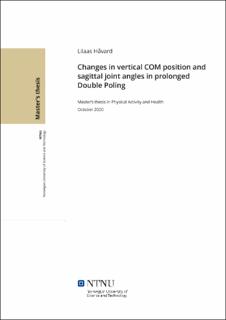| dc.contributor.advisor | Noordhof, Dionne | |
| dc.contributor.advisor | Skovereng, Knut | |
| dc.contributor.author | Lilaas, Håvard | |
| dc.date.accessioned | 2021-09-25T16:30:39Z | |
| dc.date.available | 2021-09-25T16:30:39Z | |
| dc.date.issued | 2021 | |
| dc.identifier | no.ntnu:inspera:82525395:10364846 | |
| dc.identifier.uri | https://hdl.handle.net/11250/2783221 | |
| dc.description.abstract | Summary in Norwegian
Introduksjon: Staking er regnet som den raskeste delteknikken i morderne, klassisk langrenn. Avstanden i konkurranse er varierende og kan være mellom 1-50 km i FIS World Cup til 40-90 km i Visma Ski Classics (VSC). At langrennsløpere trenger god utholdenhet er godt dokumentert, men det mangler kunnskap om hvordan utmattelse påvirker det vertikale tyngdepunktet og kinematikk i staking. Formålet med denne studien var derfor å undersøkte hvordan langvarig staking påvirker det vertikale tyngdepunktet og leddvinklene i sagittalplanet.
Metode: Ni deltakere (alder 22.5 år ± 2.5, høyde 180.2 cm ± 1.6, vekt 74 kg ± 2.4) gjennomførte tre dager med testing på en tredemølle på 6% stigning med rulleski. Dag 1 bestod av laktatprofil, 30 sekunders sprint på stakeergometer (PPO) og maksimalt oksygenopptak (VO2-peak). Dag 2 og 3 bestod av en henholdsvis 1 og 2 timer submaksimal bolk etterfulgt av laktatprofil, PPO og VO2-peak. Qualisys Track Manager (QTM) ble brukt til å måle kinematikk i staking underveis og ble videre analysert i Visual 3D (V3D) og MatLab. Statistiske analyser ble gjennomført i IBM SPSS 25.0.
Resultat: Langvarig staking resulterte i en nedgang i prestasjon som er definert som nedgang i maks hastighet (F(2, 7)= 3.37, p<0.05). Utmattelse førte til en lavere posisjon av zCOM (F(2, 6)= 5.87, p<0.05), samt økt maksimal fleksjon i henholdsvis hofte- (F(2, 4)= 3.71, p<0.05) og kneleddene (F(2, 6)= 5.29, p<0.05).
Konklusjon: To timer med langvarig staking resulterte i en nedgang i prestasjon, som henger sammen med forskyvningen av det vertikale tyngdepunktet endringen i leddvinklene i sagittalplanet. | |
| dc.description.abstract | Abstract
Introduction: Double poling is considered the fastest classic sub-technique in modern day Cross-Country Skiing (XCS). The distance in competition vary from 1-50 km in the FIS World Cup to 40-90 km in the Visma Ski Classics (VSC). Due to that, the sport requires the ability to perform over longer periods. However, the effects of fatigue on center of mass (COM) and double poling (DP) kinematics is not well investigated. This study investigated the effect of fatigue on the vertical COM-position and the sagittal plane joint angles in prolonged DP. Prolonged DP will most likely result in fatigue, which will influence the vertical COM-position and the sagittal plane joint angles.
Methods: Nine male participants (22.5 y ± 2.5, 180.2 cm ± 1.6, 74 kg ± 2.4) performed DP at 6% incline on a treadmill on 3 separate days. Day 1 consisted of lactate profile, peak power output (PPO) and peak oxygen uptake (VO2-peak). Day 2 and 3 consisted of 1- and 2 h submaximal DP (65% of VO2-peak), lactate profile, PPO and VO2-peak. DP kinematics were captured using Qualisys Track Manager (QTM) and analyzed in Visual 3D (V3D). Statistical analysis was conducted in IBM SPSS 25.0.
Results: Prolonged submaximal DP resulted in a decline in performance indicated by a lower max speed (F(2, 7)= 3.37, p<0.05). Fatigue lowered the min zCOM (F(2, 6)= 5.87, p<0.05), and fatigue increased the maximum flexion of the hip- (F(2, 4)= 3.71, p<0.05) and knee joints (F(2, 6)= 5.29, p<0.05).
Conclusion: Two hours of prolonged DP resulted in a decline in performance, which coincided with vertical COM displacement and changes in sagittal joint angles. | |
| dc.language | eng | |
| dc.publisher | NTNU | |
| dc.title | Changes in vertical COM position and sagittal joint angles in prolonged Double Poling | |
| dc.type | Master thesis | |
